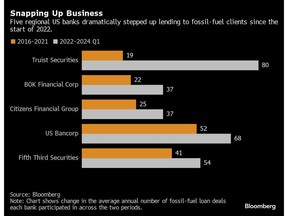Article content
(Bloomberg) — As the world veers further off course from its goal of limiting global warming to 1.5C above pre-industrial levels, banks are increasingly having to pay attention to the financial implications of a rapidly-warming planet.
The economic shocks inherent to the current trajectory of global warming may leave banks facing loan losses and impaired balance sheets. The Basel Committee on Banking Supervision has said climate change has the potential to affect “the safety and soundness of banks and the stability of the broader banking system.”
Article content
Until recently, banks have mainly focused on what so-called transition risks mean for their underlying business. These risks are tied to changes in asset values and other costs associated with the decarbonization of the global economy.
But as temperatures soar around the world, triggering a deadly cocktail of wildfires, storms and drought, banks are now being forced to pay greater attention to what are known as “physical risks.”
The potential losses from extreme events and long-term changes in weather patterns are becoming more prominent, forcing the financial industry to “sharpen its understanding” of physical risks, said Gianluca Cantalupi, head of climate, nature and social risk at JPMorgan Chase & Co.
And there’s little secret why. Here are just some of the recent calamities: Floods in Pakistan wiped out 2.2% of the country’s gross domestic product in 2022; Canada’s worst wildfire season on record in 2023 took a heavy toll on the local economy; and a crippling drought at the Panama Canal has impaired a waterway that handles $270 billion a year in global trade.
Article content
“These events are happening more and more frequently, and so we need to be educated—to be risk-aware,” Cantalupi said. “I need to know the physical risks the bank might face when making lending decisions: Will a semiconductor company face water stress? Will logging in certain provinces cause landslides that destroy factories or other infrastructure?”
To prepare for an increasing number of environmental disasters, JPMorgan has been adding personnel to assess such risks, including Cantalupi, who joined late last year from Credit Suisse. The bank is hiring catastrophe modelers that can estimate the potential impact of severe weather events on JPMorgan’s real estate portfolios.
In December, analysts at BloombergNEF published a report stating that the impact on companies from extreme climate events can range from a reduction in revenue all the way to bankruptcy, though few are cognizant of the risks they face. The research found that 65% of the more than 2,000 companies analyzed failed to identify areas of their operations that may be vulnerable to physical risks, and even fewer companies conduct financial assessments of climate-related risks
Article content
Citigroup Inc. said last month in its climate report that the physical impacts of climate change can cause a host of other worries, such as credit, liquidity and operational risks. To assess the vulnerability of its credit exposures to climate risks, the bank has introduced what it calls a Climate Risk Heat Map, which shows the business areas with the highest physical risks and transition risks.
According to Citigroup, its $15.8 billion oil and gas production loan book has a transition risk score of 4, the highest, and a physical risk score of 3. The two sectors with the highest physical risk scores are semiconductors and ports.
“It’s become a bigger issue,” especially over the past six months, said Andrew Karp, global head of the sustainable banking solutions group at Bank of America Corp. “There’s a growing worry about rising costs and, in some cases, a reduced availability of insurance and what that says about how climate risk will manifest into financial risks.”
Sustainable finance in brief
Despite this increasing awareness of the grave threat posed by runaway global warming, American banks are nevertheless increasing their bets on the industry most responsible for its acceleration. A group of US regional banks is ratcheting up lending to oil, gas and coal clients, grabbing market share as bigger European rivals back away. The list of fossil fuel funders includes Citizens Financial Group Inc., BOK Financial Corp. and Truist Securities Inc., according to data compiled by Bloomberg. The companies have climbed between 13 and 40 steps up the league table for Big Oil financiers since the end of 2021, placing them among the world’s top 35 banks by number of deals. Fifth Third Securities Inc. and US Bancorp, already in the top 30, both ascended 10 steps in the same period.
Share this article in your social network

